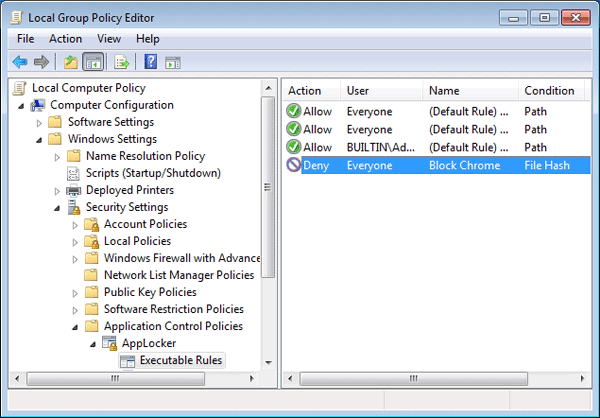
- #Applocker group policy how to
- #Applocker group policy software
- #Applocker group policy windows 7
- #Applocker group policy series
- #Applocker group policy windows
#Applocker group policy windows
Allow administrators to run all Windows Installer files Note: The variable %systemdrive% refers to the drive where the Windows folder is located, which is typically C: – Allow everyone to run all Windows Installer files in the %systemdrive%\Windows\Installer path – Allow everyone to run all digitally signed Windows Installer files If you right-click the Windows Installer Rules node and select Create Default Rules, the following recommended default rules are created:įigure 1 AppLocker running on Windows Server 2008R2 This section is used to restrict installation routines. Notice the Windows Installer Rules section.
#Applocker group policy windows 7
– The Application Identity service must be configured to start automatically when the Windows 7 clients start.įigure 1 shows the AppLocker interface within a GPO on Windows Server 2008 R2. – You must be running Windows 7 Enterprise or Ultimate Edition on all clients you wish to control through AppLocker. If you want to use AppLocker, the following must be true:
#Applocker group policy software
Note:You can also enable this Group Policy setting through a domain-based GPO so that it automatically applies to AD DS domain users.ĪppLocker is a new feature in Windows 7 (Enterprise and Ultimate Editions only) that provides for advanced software restrictions, including the control of Windows Installer routines. Enable the policy named Hide “Programs and Features” Page. Expand User Configuration ⇒ Administrative Templates ⇒ Control Panel ⇒ Programs.ģ. Click Start and search for gpedit.msc and press Enter.Ģ. To remove the Programs and Features page, follow these steps on a local machine:ġ. Both methods are covered in this section. Second, you can explicitly restrict access to installation routines using AppLocker. First, you can remove the Programs and Features page so that users cannot add Windows OS features that are not already installed on their machines. You can use Group Policy to restrict application installations directly in two ways. You’ll also learn the steps required to deploy applications using Group Policy Objects.

#Applocker group policy how to
This section shows you how to restrict application installation and access to removable media using Group Policy. It is also possible to test from PowerShell whether specific files are allowed to run.Group Policy plays a significant role in application management and control. Configuring AppLocker through local group policy is possible, too.Īdditionally, rules can be created from PowerShell. The relevant node is: Computer Configuration -> Policies -> Windows Settings -> Security Settings -> Application Control Policies -> AppLocker. Hash: applies to individual files identified by their hash value (note that if a file is updated or patched the hash changes and the rule becomes invalid).ĪppLocker rules are typically distributed by domain-based group policy.Path: applies to files in a certain path or to individual files in a specific location.Can optionally be limited to a certain product name, file name and file version. Publisher: applies to all files that are digitally signed by a certain organization.This makes it possible to differentiate between restricted standard users and unrestricted power users, for example.ĪppLocker has three different types of rules:

Rules apply to users or groups, not computers. Similar to a firewall, AppLocker works with rules that control whether to log, permit or deny an operation. It is therefore easily possible to audit scripts, enforce applications and leave installers and DLLs alone. The mode of operation is configured for each file type individually. Individual App-V applications (App-V works with AppLocker, it is just not possible to block only certain applications).ĪppLocker can operate in auditing mode, enforcement mode or switched off completely.As an alternative, the 16 bit subsystem could be blocked entirely. As an alternative, the Posix subsystem could be disabled.


If, for example, perl.exe is blocked, no Perl script can be executed. The host process may be blocked entirely, though. Individual scripts that run in their own host process (e.g.Scripts (*.bat, *.cmd, *.js, *.ps1, *.vbs)ĪppLocker does not audit or control the execution of:.File TypesĪppLocker monitors and/or controls the execution of the following types of files: Contrary to popular belief the service is not required for rule enforcement – stopping it does not unblock restricted applications. The Application Identity service must be running or configuration changes cannot be processed. Server 2008 R2 Standard, Enterprise or Datacenterĭomain controllers must be running at least Windows Server 2003.
#Applocker group policy series
This is the first in a small series of articles about AppLocker, a technology built into Windows that enables administrators to audit and optionally block application execution.


 0 kommentar(er)
0 kommentar(er)
